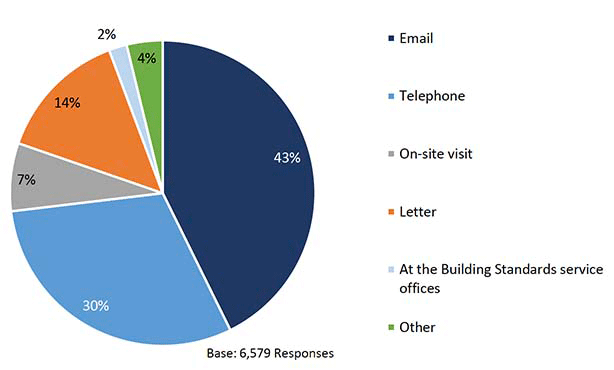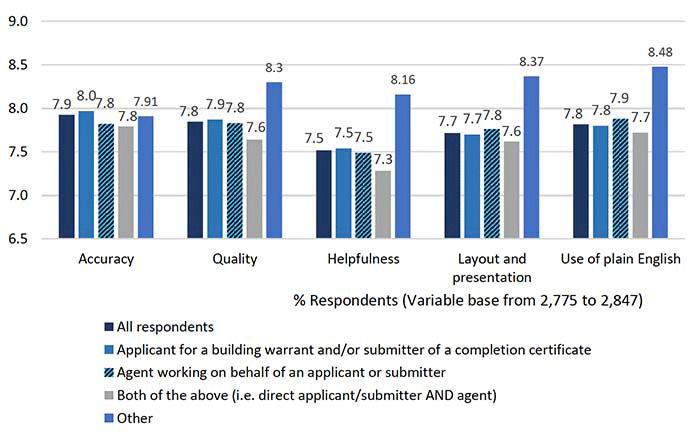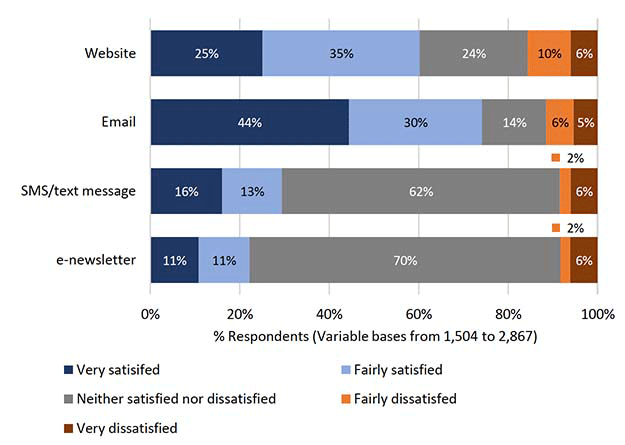Building Standards verification performance framework - national customer satisfaction survey: survey findings 2021
Results from the National Customer Satisfaction Survey 2021 giving a summary of local authority performance of the National Performance Framework.
This document is part of 2 collections
8. Communications
8.1. Channels of Communication
1. Surveyed customers interact with local authority verifier building standards using a variety of channels. Email and telephone communications are the most popular forms (together accounting for 73% of responses) followed by on-site visits and hard-copy letters (Figure 8.1.a). These results are similar to previous years, although email has become slightly more commonplace, while interactions at Building Standards offices have dropped from 6% in 2020 to 2% in 2021.
2. On average, customers reported using 2.1 channels of communication and the proportional mix is broadly similar between applicants and agents, although direct applicants are more likely to interact via an on-site visit (15%) compared to agents (9%), whle agents are more likely to use a telephone approach (34%) compared to applicants (29%).

Source Pye Tait Consulting, 2021
3. The 4% of responses classified as 'other' primarily stem from direct applicants interacting with the building standards service via an agent, architect, or builder, while some indicated no contact at all with building standards services. Both agents and direct applicants using the online portal and attending virtual meetings, replacing site visits and inspections due to Covid-19, were also stated. Microsoft Teams and Zoom were the two most cited platforms for video calls.
8.2. Written Information and Documentation
1. On a scale from 1 'very poor' to 10 'very good', customers were asked to rate different aspects of the written information and documentation they received from their local authority verifier.
2. The resulting average ratings fall between 7.5 and 7.9 out of 10, which is a decrease from a range of 7.8 to 8.2 in 2020 (Figure 8.2.a).

Source Pye Tait Consulting, 2021
8.3. Electronic Communications
1. Customers were asked to rate their satisfaction with specific forms of electronic communication made available by their local authority building standards service.
2. Just under three quarters (74%) are satisfied with email communications – an increase of 1% from 2020. Around three in five (60%) are satisfied with the local authority verifier's website – a slight fall from 63% in 2020 and 66% in 2019.
3. The base number of respondents rating their satisfaction with SMS/text message and e-newsletter communications is about half that of other forms, indicating that these methods of communication are not as widespread[12] (Figure 8.3.a).

Source Pye Tait Consulting, 2021
8.4. Customers Stating 'Very/Fairly Dissatisfied
1. Respondents stating 'fairly dissatisfied' or 'very dissatisfied' with respect to at least one of the above forms of electronic communication were asked to give their reasons.
2. Based on 540 responses, the main themes echo those raised over the past six years. In particular:
- Emails are not always answered, or the speed of response is slow;
- Websites are confusingly laid out and unintuitive, making it difficult to find the information needed, especially for non-IT literate users.
"I found the website communication system not fit for the first-time user. Only use able by those who understand the jargon and quirks of the system." (Direct applicant)
"I personally find the electronic website difficult to use and understand." (Direct applicant)
"No response to emails other than a "standard" acknowledgement and then - nothing for weeks / months." (Agent)
3. There were very few reasons provided by customers dissatisfied with SMS/text message and e-newsletter communications. Most seemed unaware that communications might be available through these channels. Some respondents received emails stating staff are working from home due to the Covid-19 pandemic and can therefore accept that there will be delays, however some are left waiting months for a response.
8.5. eBuilding Standards
1. Whilst a direct question was not asked on the topic of eBuilding Standards, there has been some feedback consistent with reports from the past few years.
2. Of the 98 people who provided feedback on the portal, the majority of suggestions relate to making the portal easier to understand, easier to access, and providing explanatory notes or guidance for the electronic process. Some applicants indicated that officers were not always able to access documents uploaded through the portal and there was no clear option to communicate via email instead of via the portal.
8.6. Improving Communications in the future
1. Customers were asked in what ways the local authority verifier building standards service could improve its overall communications in the future. The main suggestions include:
- Returning emails more efficiently and timeously, with many respondents suggesting this is non-existent;
- Expanding phone services available to customers, or allow for officers to be contactable via phone, again with many suggesting this is not possible at present;
- Improving response times on applications, or providing a more realistic timescale at the outset;
- Being more proactive, customer oriented and commercially aware;
- Employing more staff;
- Ensuring greater consistency in the quality of service from all staff, within and between local authorities;
- Improving navigability and functionality of the website to ensure it is more user-friendly;
- Using clearer (plain) English in written documents and communications; and
- Providing clearer and more specific instructions for the actions that applicants need to take, particularly for first time applicants.
2. Respondents did acknowledge that responses to emails and phone calls may have been delayed because of the Covid-19 pandemic and were generally accepting of this. However, some respondents indicated that, due to changes implemented to enable home working, communication had become impossible (such as forwarding to mobiles instead of office telephones). A number of respondents stated that they would prefer to meet with someone face to face or call someone directly to discuss their application and building process rather than rely electronic communications.
"The website is sometimes hard to navigate through and find what you are looking for. Maybe try to make it more user friendly to people who have never applied before." (Direct applicant)
"Respond in a timely manner to submission of documents and not leave it until the final moment to respond. I don't know if this is a staffing issue or just the culture, but it unnecessarily slows down the whole process." (Direct applicant)
"Allow BS officers to discuss issues on the phone, without having to resort to e-mail communications for every issue no matter how minor. Please issue mobile numbers of the case officers with the warrant notes." (Agent)
"Remembering to use clear layperson's language, which can be difficult for technical information, but is essential for the customer to be able to understand and comply." (Direct applicant)
"Direct communication to the officer would be helpful, or to a duty officer." (Agent)
"Regular proactive communication on progress - even to say expenses delays / lead times - no word is very frustrating and does not allow us to plan." (Direct applicant)
Contact
Email: buildingstandards@gov.scot
There is a problem
Thanks for your feedback